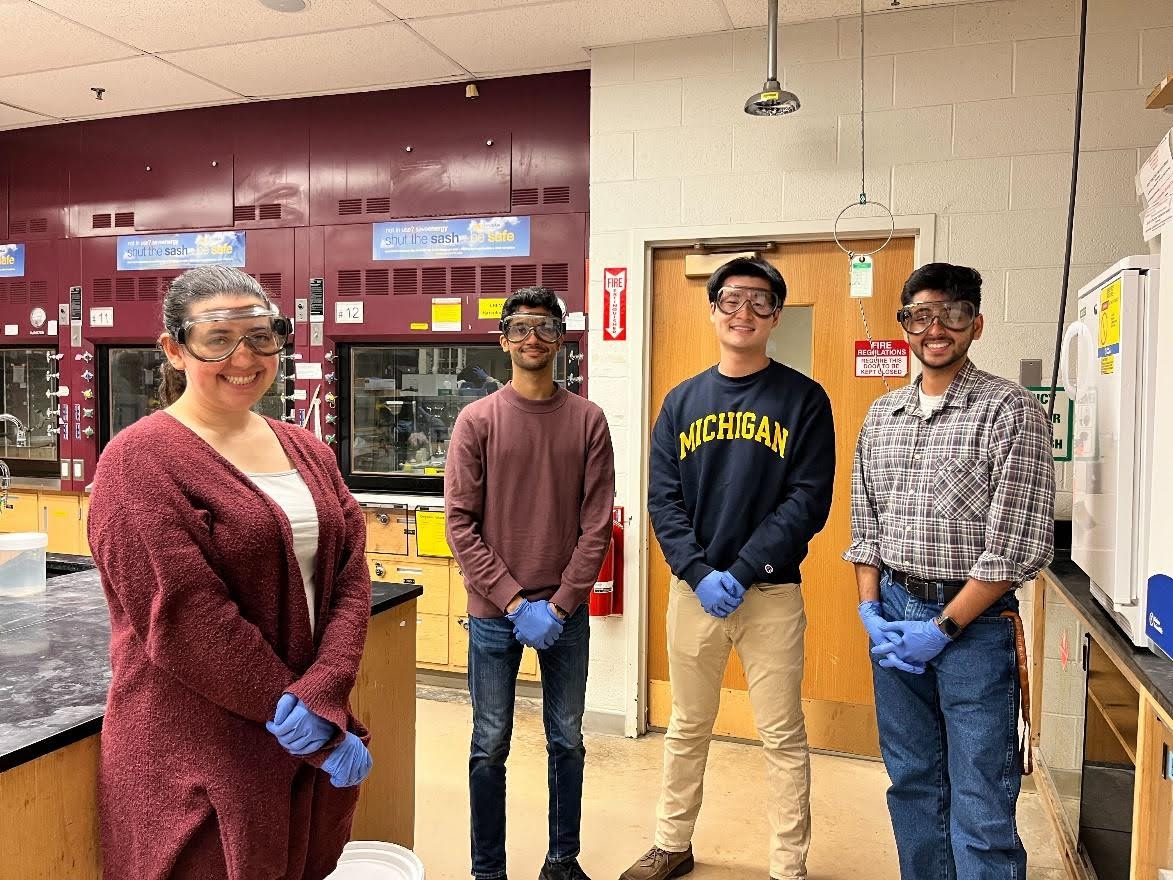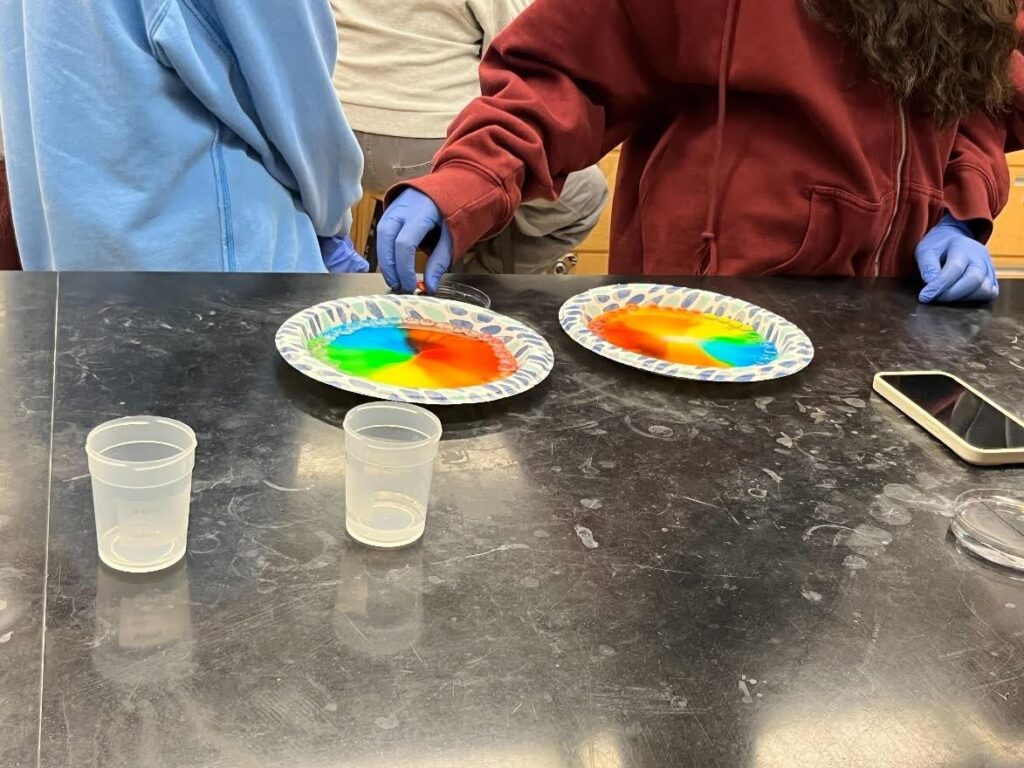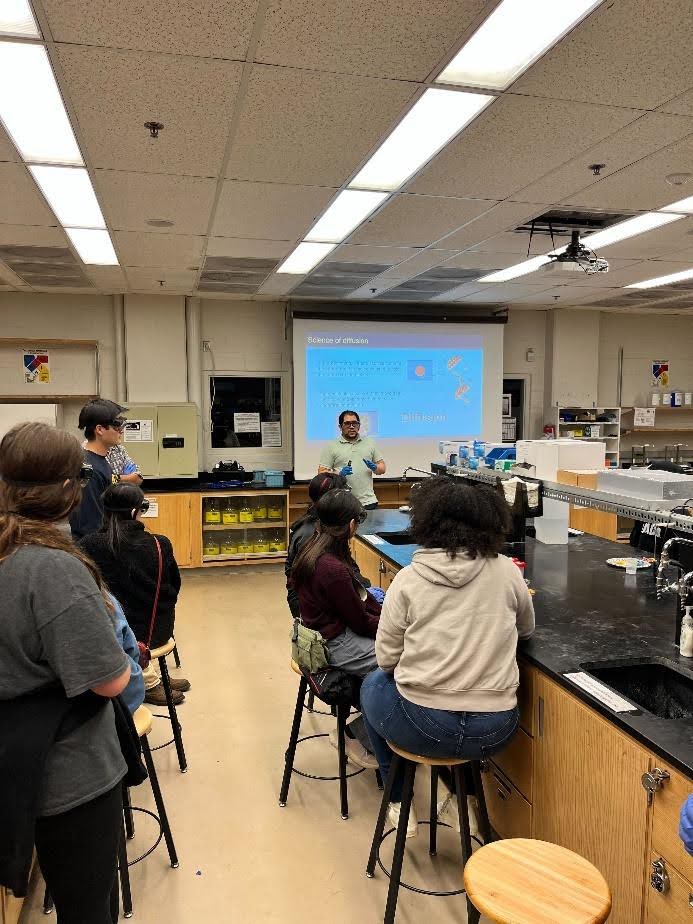
Science in everyday life: bridging theory and practice in high school outreach program
Graduate students from the Kamcev and Min Labs recently worked with local high school students interested in exploring STEM.

Graduate students from the Kamcev and Min Labs recently worked with local high school students interested in exploring STEM.
A recent collaborative effort between Michigan Chemical Engineering graduate students and Women+ Excelling More in Math, Engineering, and Science (FEMMES) welcomed high school students from Ann Arbor, Ypsilanti, Dearborn and Detroit to participate in an outreach activity to learn more about diffusion and molecular movement.
Spearheaded by Chemical Engineering graduate students of the Kamcev and Min labs, Wen-Wei Wong, Anish Avasthi, Leah Oppenheimer, José Carlos Díaz, and Ajay Chavda, the session kicked off with an engaging lecture that discussed basic principles of molecular motion. Students were introduced to fundamental concepts such as diffusion and Fick’s second law, providing a comprehensive understanding of how molecules navigate their surroundings. The lecture laid the groundwork for the immersive hands-on experiments that followed, ensuring students were well-equipped with essential background information on diffusion and molecular motion.
“Diffusion is a pretty difficult concept to grasp if you are only looking at the math,” said José Carlos Díaz, a fifth-year graduate student and activity leader. “But if you look at examples of how it happens in the real world, you can quickly understand the process and what variables can affect it.”
The first experiment aimed to visually illustrate the principles of diffusion. Students strategically placed Skittles and M&M candies around a water-filled plate, initiating a bright display of color diffusion. This experiment not only offered an entertaining approach to understanding molecular movement, but also allowed students to quantify the effects of temperature on diffusion rates. By comparing trials with cold and room temperature water, participants gained valuable insights into how temperature influences molecular kinetics.

“I hope that the students come away with the idea that science can be found in everything we do,” said Wen-Wei Wong, a graduate student in the Kamcev lab and activity leader. “It is present even in an activity as simple as dropping candy into liquids. With this, I want them to become and remain curious about observations they make in their daily surroundings.”
Students also had the opportunity to explore the effects of convection, differentiating it from pure diffusion. The discussion transitioned to the impactful role of diffusion principles in pharmaceuticals and chemical engineering, including a few examples of how diffusion principles are used in aspects of drug development, chemical separation and water purification.
The activity also featured an exciting challenge designed to test students’ strategic thinking and understanding of the diffusion coefficients they learned about during the lecture. For the challenge, students were tasked with adding drops of concentrated salts including iron(II) sulfate and potassium ferricyanide at opposite ends of a water-filled petri dish. The objective was to orchestrate a chemical reaction in the middle of the petri dish. At the interface of the two solutions, a chemical reaction happens where the colorless iron solution and the pale yellow ferricyanide solution react to produce the visually striking Prussian blue pigment.
This challenge required precise timing and a keen awareness of each salt’s diffusion characteristics. Through multiple trials, students honed their experimental skills while learning about the practical application of diffusion principles in helping orchestrate chemical reactions at precise locations—a crucial aspect of real-world scientific research.
This outreach activity, along with other collaborations between FEMMES and the Department of Chemical Engineering, aims to make complex scientific concepts accessible and enjoyable for high school students. This event offers a dynamic and interactive platform for student exploration that supplements traditional classroom learning. Beyond the scientific principles, students developed problem-solving skills, scientific curiosity and an appreciation for the practical applications of diffusion in various fields.
“One of the considerations when designing an activity aimed at high school students is to design an experiment that can simultaneously build upon their current understanding of the concept while challenging them with an appropriate level of difficulty to keep them engaged in the activity,” Wong said. “This idea is important at all levels of science and especially so with high school aged students. We hope as the students’ interest in STEM grows, they can experience more and more advanced experiments.”

The success of this workshop was made possible with the support of Joseph Ward, the Chemistry Department’s laboratory manager, and Guenther Kellner, the laboratory coordinator. The event was part of the FEMMES Advanced Capstone, a full-day program providing guidance and workshops for 9-12 grade students on college applications and scientific exploration.
“It was a true joy to guide high school students through, what was for many of them, a completely new concept. Watching their understanding grow, seeing the light of success in their eyes as they applied what they had just learned about diffusion, was absolutely priceless,” said Ajay Chavda, a graduate student in the Min lab and activity leader. “It brought back fond memories of my own first steps into the world of scientific discovery. Building that bridge between teaching and learning, reminded me how enriching STEM can be.”